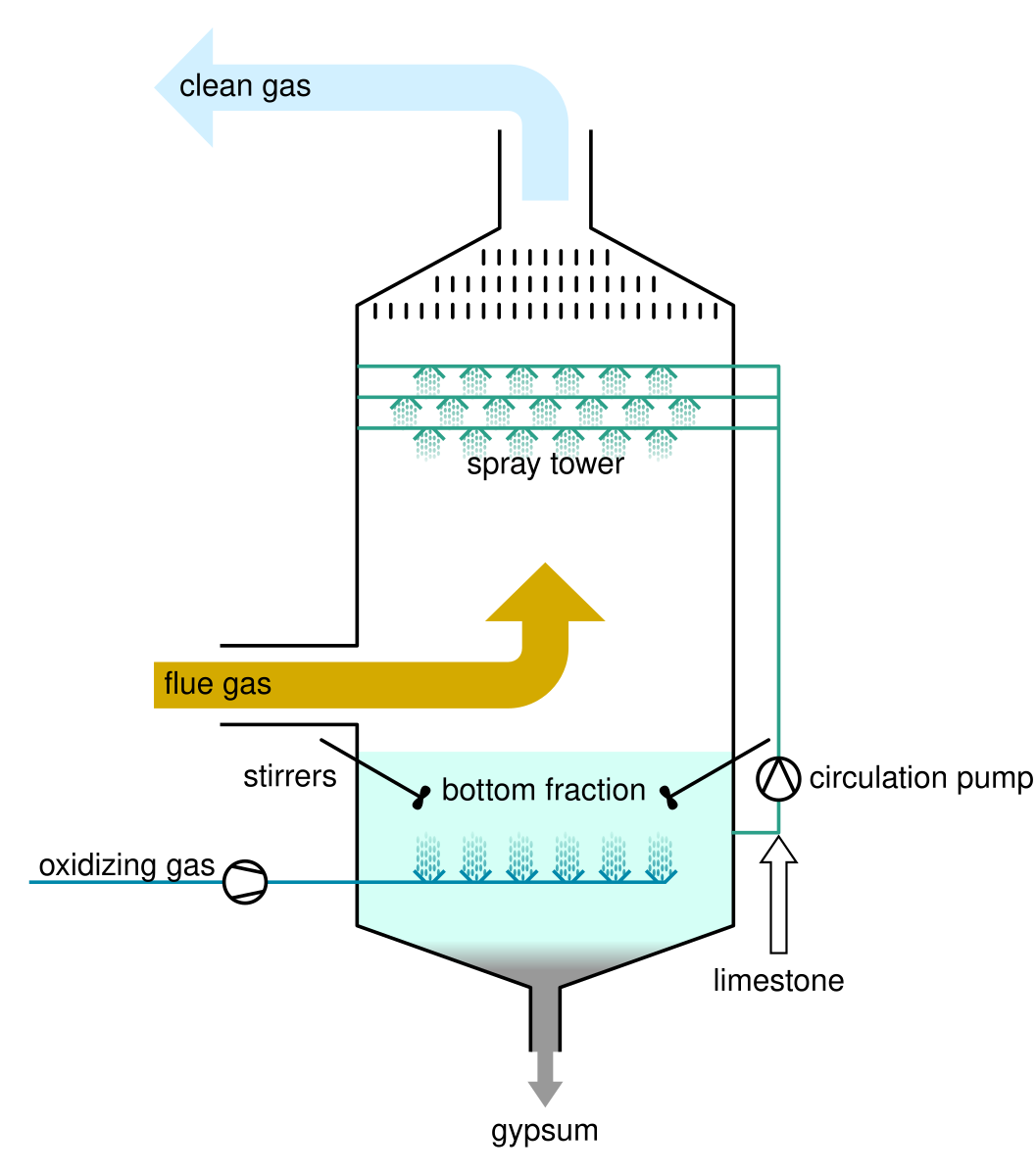IB Syllabus focus:
‘Reduce emissions (alternative energy), control at source (scrubbers, catalytic converters), and restore systems (healthcare, liming lakes, nutrient additions) to minimize ecological and societal damage.’
Managing nitrogen oxides (NOx) and sulphur dioxide (SO2) emissions is critical for reducing ecological degradation and human health risks. Strategies address prevention, control, and system restoration.
Understanding NOx and SO2 Impacts
Key pollutants
NOx (nitrogen oxides) and SO2 (sulphur dioxide) are primary air pollutants, mainly produced by fossil fuel combustion in vehicles, power stations, and industrial facilities.
NOx contributes to the formation of photochemical smog, tropospheric ozone, and acid rain.
SO2 dissolves in water vapour, forming sulphuric acid, a key component of acid deposition.
Both pollutants have environmental impacts (soil acidification, freshwater toxicity, forest dieback) and human health impacts (respiratory illness, cardiovascular stress).
Strategies to Manage NOx and SO2
1. Reducing emissions (Prevention at the source)
The most effective long-term approach is reducing the production of pollutants before they are released. This involves transitioning to alternative energy sources.
Renewable energy: Solar, wind, hydro, and geothermal replace fossil fuels, eliminating combustion emissions.
Low-sulphur fuels: Cleaner fuels produce less SO2 when burned.
Energy efficiency: Improved building design, efficient transport, and low-energy appliances reduce overall fuel consumption.
Alternative Energy: Energy derived from renewable sources such as solar, wind, or hydro, which do not rely on burning fossil fuels and therefore reduce pollutant emissions.
Reducing emissions not only limits air pollutants but also mitigates climate change, as many NOx and SO2 sources also emit greenhouse gases.
2. Controlling at the source (Technology-based solutions)
If fossil fuels remain in use, technology can limit the release of pollutants at the point of combustion.
Scrubbers: Devices installed in smokestacks that use alkaline substances, such as lime or seawater, to neutralise SO2 before it enters the atmosphere.

Simplified absorber diagram of a wet flue-gas desulfurization unit showing gas flow, spray nozzles, slurry circulation, demister, and cleaned-gas outlet. This visual clarifies how alkaline reagents contact flue gas to remove SO₂ prior to release. It focusses on the operational components relevant to source-control methods. Source.
Catalytic converters: Installed in car exhaust systems, these devices promote chemical reactions that convert harmful NOx gases into less harmful nitrogen and oxygen.
Catalytic Converter: A device in vehicle exhausts that uses catalysts to accelerate chemical reactions, converting NOx into nitrogen gas and oxygen, and CO into CO₂.
Low-NOx burners: Designed to reduce combustion temperatures, thus lowering NOx formation.
Electrostatic precipitators: Remove particulates that often carry absorbed SO2, further reducing air pollution.
These methods minimise local emissions and are particularly effective in urban and industrial regions.
3. Restoring affected systems (Remediation and recovery)
Even with emission controls, past and ongoing pollution requires remediation. Restoration seeks to reduce the damage already caused by NOx and SO2.
Healthcare responses: Treating respiratory illnesses linked to air pollution, improving urban health services.
Liming lakes: Adding crushed limestone (calcium carbonate) to neutralise acidified waters, restoring aquatic ecosystems.

Historic field photograph of hydrated lime being sprayed from a small boat to neutralise an acidified lake. This illustrates how liming is applied in practice to restore pH and aquatic life following acid deposition. Image focuses on application method; extraneous historical context is omitted. Source.
Nutrient additions: Applying fertilisers to acidified soils can help re-establish plant growth, although this is a short-term measure.
Liming: The process of adding alkaline material, such as limestone, to acidified lakes or soils to neutralise acidity and restore ecological balance.
Restoration strategies help maintain biodiversity, safeguard ecosystem services, and protect human well-being.
Balancing Approaches
Preventive vs corrective strategies
Preventive approaches (renewable energy, efficiency) target root causes and provide sustainable long-term benefits.
Corrective approaches (scrubbers, liming) manage existing damage but often involve higher costs and continuous intervention.
Economic and social considerations
Economic costs: Installing scrubbers or transitioning to renewables requires large investments, but savings occur in healthcare and environmental protection.
Social benefits: Cleaner air reduces respiratory diseases, improves quality of life, and lowers healthcare expenditure.
Policy measures: Governments may introduce emission standards, carbon pricing, or subsidies for clean technology to encourage adoption.
Key Takeaways for IB Students
NOx and SO2 cause acid deposition, ecosystem degradation, and human health risks.
Management involves three levels:
Reduce emissions: Renewable energy, energy efficiency, low-sulphur fuels.
Control at source: Scrubbers, catalytic converters, low-NOx burners.
Restore systems: Healthcare, liming lakes, soil nutrient additions.
Strategies are shaped by economic feasibility, political will, and social needs, making management a complex and multi-level process.
FAQ
Wet scrubbers use a liquid, often an alkaline slurry, to absorb and neutralise sulphur dioxide from flue gases.
Dry scrubbers use dry reagents, such as powdered lime, which react with SO2 to form solid by-products that can be collected.
Wet scrubbers are generally more efficient, but dry scrubbers are cheaper to install and maintain in smaller facilities.
Liming rapidly increases pH levels, creating conditions suitable for fish, invertebrates, and plants to return.
Fish species sensitive to acidity, such as trout, can repopulate.
Aquatic plants recolonise, stabilising ecosystems.
Invertebrate diversity increases, improving food web stability.
However, liming must be repeated over time, as underlying acid deposition may continue.
Catalytic converters need to reach a high operating temperature (around 250–400°C) to function efficiently.
In cold climates or during short trips, engines may not heat the converter enough to catalyse reactions.
This reduces the effectiveness of NOx removal, leading to higher emissions during initial engine operation.
While fertilisers can support plant regrowth in degraded soils, they only provide short-term relief.
They do not neutralise soil acidity.
They may cause eutrophication in nearby water bodies.
Regular application is costly and unsustainable.
Therefore, nutrient additions are considered supplementary rather than a long-term restoration strategy.
Low-NOx burners are designed to lower the combustion temperature, reducing the formation of nitrogen oxides.
They achieve this by:
Staging the fuel and air supply to limit oxygen during initial combustion.
Promoting more complete fuel mixing at later stages.
By lowering flame temperature and controlling oxygen levels, the amount of NOx formed during combustion is significantly reduced.
Practice Questions
Question 1 (2 marks)
Identify two strategies used to reduce sulphur dioxide (SO2) emissions from power stations.
Mark scheme:
Award 1 mark for each valid strategy, up to 2 marks.
Example answers:
Installation of scrubbers in smokestacks (1 mark).
Use of low-sulphur fuels (1 mark).
Switching to renewable energy sources such as wind or solar (1 mark).
Question 2 (5 marks)
Discuss how strategies to manage nitrogen oxides (NOx) and sulphur dioxide (SO2) can be grouped into prevention, control at source, and restoration. Provide one example for each category.
Mark scheme:
Clear identification of prevention strategy (1 mark).
Appropriate explanation of prevention (e.g. renewable energy reduces combustion pollutants) (1 mark).
Clear identification of control at source strategy (1 mark).
Appropriate explanation of control at source (e.g. catalytic converters reduce NOx emissions from vehicles) (1 mark).
Clear identification and explanation of restoration strategy (e.g. liming lakes neutralises acidity caused by deposition) (1 mark).
Maximum 5 marks. Answers must cover all three categories with at least one example each to achieve full marks. Partial answers receive partial credit.

